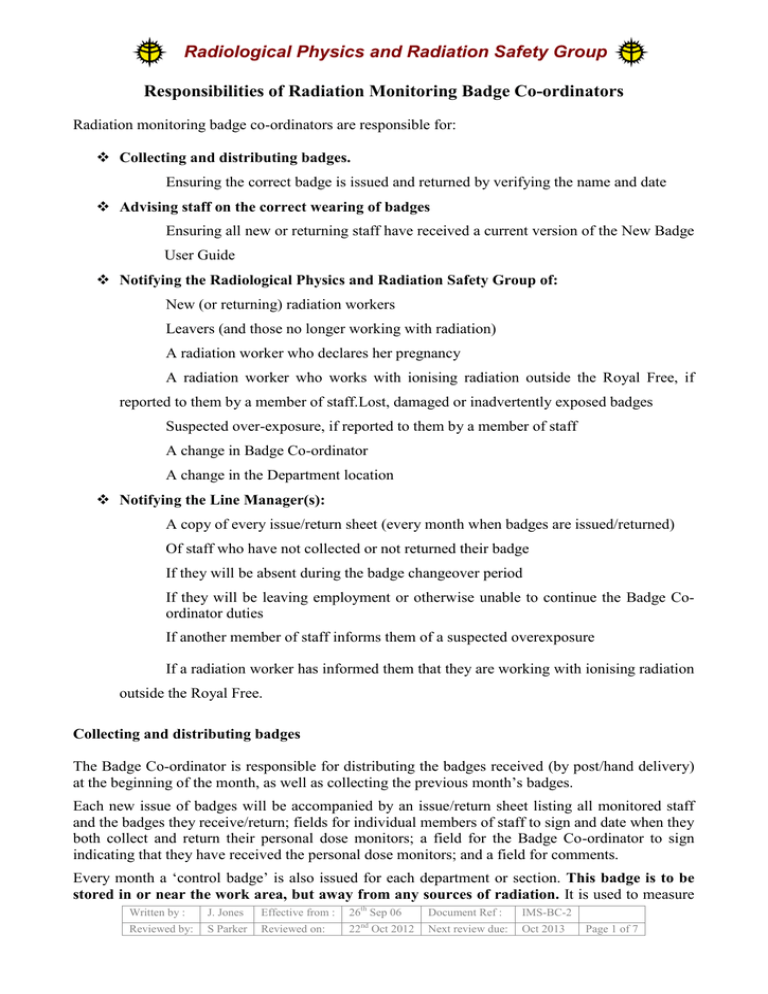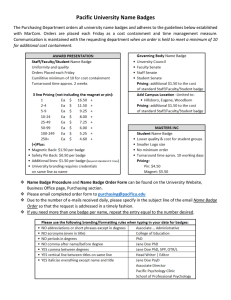Radiological Physics and Radiation Safety Group
advertisement

Radiological Physics and Radiation Safety Group Responsibilities of Radiation Monitoring Badge Co-ordinators Radiation monitoring badge co-ordinators are responsible for: Collecting and distributing badges. Ensuring the correct badge is issued and returned by verifying the name and date Advising staff on the correct wearing of badges Ensuring all new or returning staff have received a current version of the New Badge User Guide Notifying the Radiological Physics and Radiation Safety Group of: New (or returning) radiation workers Leavers (and those no longer working with radiation) A radiation worker who declares her pregnancy A radiation worker who works with ionising radiation outside the Royal Free, if reported to them by a member of staff.Lost, damaged or inadvertently exposed badges Suspected over-exposure, if reported to them by a member of staff A change in Badge Co-ordinator A change in the Department location Notifying the Line Manager(s): A copy of every issue/return sheet (every month when badges are issued/returned) Of staff who have not collected or not returned their badge If they will be absent during the badge changeover period If they will be leaving employment or otherwise unable to continue the Badge Coordinator duties If another member of staff informs them of a suspected overexposure If a radiation worker has informed them that they are working with ionising radiation outside the Royal Free. Collecting and distributing badges The Badge Co-ordinator is responsible for distributing the badges received (by post/hand delivery) at the beginning of the month, as well as collecting the previous month’s badges. Each new issue of badges will be accompanied by an issue/return sheet listing all monitored staff and the badges they receive/return; fields for individual members of staff to sign and date when they both collect and return their personal dose monitors; a field for the Badge Co-ordinator to sign indicating that they have received the personal dose monitors; and a field for comments. Every month a ‘control badge’ is also issued for each department or section. This badge is to be stored in or near the work area, but away from any sources of radiation. It is used to measure Written by : Reviewed by: J. Jones S Parker Effective from : Reviewed on: 26th Sep 06 nd 22 Oct 2012 Document Ref : IMS-BC-2 Next review due: Oct 2013 Page 1 of 7 Radiological Physics and Radiation Safety Group the local background radiation and therefore should not be stored in a metal container or near sources of heat. This badge must be returned at the end of the monitoring period with the rest of the same month’s badges. The new personal dose monitors should be distributed to staff according to local procedures which suit working practice in each area. Each member of staff collecting their new personal dose monitors must sign and date the new month’s issue form. Note that finger and collar monitors are signed for along with the TLD/film badges. The previous month’s personal dose monitors, including the control badge, must be collected according to local procedures that suit working practice in each area. The previous month’s issue form should be signed and dated by each member of staff returning their dose monitor. Note that each of these issue/return forms are for one month only. Hence when collecting a badge from the previous month and issuing a new one, ensure staff sign and date on two separate sheets, one for the previous month’s return and the other for the current month’s issue. The Badge Coordinator must also sign to indicate that they have received the returned dose monitor. The Badge Coordinator may add comments, e.g. if the dose monitor has been lost, damaged, not issued, available/issued but not used, or if it is unavailable for any other reason. When all available personal dose monitors have been collected from the previous month, the Badge Co-ordinator retains the original and should take copies of the previous month’s issue/return sheet and circulate these as follows: one copy to the Radiological Physics Radiation Safety Group (RPRSG) along with the returned personal dose monitors one copy to each of the managers listed on the issue/return sheet (local procedures may include different managers for medical and non-medical staff) This should be done by the 5th working day of the month AT THE LATEST. If some personal dose monitors have not been returned by this date, the Badge Co-ordinator MUST inform the appropriate manager(s), but must not delay in returning those dose monitors that have been returned. Returned badges should be sent or taken directly to: The Radiological Physics and Radiation Safety Group Department of Medical Physics and Bioengineering The Royal Free Hospital London, NW3 2QG. 020 7317 7732 (direct line) or ext: 35639. It is important that the Badge Co-ordinator sends a copy of the completed issue/return sheet to their manager(s) so that managers can take quick action if staff are not collecting or returning their badges. If any dose monitors are returned late, the Badge Co-ordinator should amend the retained original issue form, take copies and forward the dose monitors and issue forms as described previously. If the Badge Co-ordinator knows that they are going to be absent during a badge change-over period, they should ensure that the Deputy Badge Co-ordinator carries out these duties. If both coordinators will be absent, they must inform their line manager so that alternative arrangements can be made. All line managers should ensure these duties are carried out. It is useful if the Badge Coordinator and deputy are also proactive in ensuring that badge changeover happens in a timely manner. Written by : Reviewed by: J. Jones S Parker Effective from : Reviewed on: 26th Sep 06 nd 22 Oct 2012 Document Ref : IMS-BC-2 Next review due: Oct 2013 Page 2 of 7 Radiological Physics and Radiation Safety Group Advising staff on the correct wearing of badges Wholebody badges: to be worn on the trunk. Printed label on the badge facing towards the source of radiation. Badges should be worn, pinned to clothing, but under any protective gowns, aprons etc. Users must take care that badges are not discarded when uniforms are sent to the laundry. Collar badges: Should be worn at shoulder level (right way round), preferably pinned to the collar. These badges must not be covered by lead/rubber aprons or thyroid shields. Extremity monitors: Finger ring monitors should be worn on the middle finger, at a position nearest the hand, and under protective gloves. Orientation of the ring dosemeter is not important. Three sizes of finger monitors are available and the appropriate size can be requested through RPRSG. Eye dose monitors: these badges have a large adjustable Velcro strap and are worn as a headband at forehead level. Ensure that the detector in the middle of the strap is positioned in the centre of the forehead with the barcode side towards the forehead. Written by : Reviewed by: J. Jones S Parker Effective from : Reviewed on: 26th Sep 06 nd 22 Oct 2012 Document Ref : IMS-BC-2 Next review due: Oct 2013 Page 3 of 7 Radiological Physics and Radiation Safety Group Notifying the Radiological Physics and Radiation Safety Group and/or Manager(s) of: New (or returning) radiation workers. The Badge Co-ordinator must make sure that all new arrivals who will be working with radiation have filled in the ‘Application for Obtaining Personal Monitors’ form. Note: not everyone will need radiation dose monitoring with a badge, e.g. those using tritium and carbon-14. Advice on whether a worker should apply for a badge should be sought from the RPS or the RPRSG. Those workers who will be using radioactive materials will also need to fill in and submit an ‘Application to use radionuclides’ form. Forms are available on the medical school intranet at: http://www.ucl.ac.uk/medicalschool/msa/safety/radiation.htm or the Trust Freenet (http://freenet/freenetcms/?&s=27&p=901&m=1135). The form(s) must be countersigned by the RPS and the Line Manager and sent to RPRSG before the user starts working with radiation. If the worker is able to bring the completed form to the RPRSG office, a badge can often be issued straightaway. A new user will need to provide an email address but this doesn’t have to be an nhs.net email if this has not yet been set up. New users will receive the Badge User guide (also available on Freenet). They will be invited to attend the IRR99 course by the Staff Education and Development Centre (x 35936). Course information and application form is found on Freenet (http://freenet/freenetcms/default.aspx?s=48&p=1553&m=2184&cal=1549&cid=5). Locum workers, visitors and multi-site workers. It is our responsibility as a Trust to ensure all locum workers and visitors are safe in radiation areas. Ensure that you or the line manager contact RPRSG to obtain temporary monitors for locum workers and visitors. This may not be necessary if they already have a monitor during the visit. Written by : Reviewed by: J. Jones S Parker Effective from : Reviewed on: 26th Sep 06 nd 22 Oct 2012 Document Ref : IMS-BC-2 Next review due: Oct 2013 Page 4 of 7 Radiological Physics and Radiation Safety Group Regarding multi-site workers; the user states on the application form if they work with ionising radiation on any other sites outside the Royal Free Hospital. It is the trust’s responsibility to ensure all dose records are collated from various sites for such users and they do not exceed the statutory limits as explained in the Trust Procedure[See Freenet for Procedures for Personal Dosimetry under IRR99]. It the line manager’s responsibility to ensure this information is correct, but if the badge coordinator has any further information they should contact the Dosimetry Service. Leavers (and those no longer working with radiation). The Badge Co-ordinator must ensure that the RPRSG are notified as soon as possible when a monitored worker changes name, leaves, moves department or no longer works with radiation. When a radiation worker declares a pregnancy. If a member of staff informs the Badge Co-ordinator that they are pregnant, the Badge Co-ordinator should try to ensure that the member of staff formally declares her pregnancy as soon as it is practicable to do so. The worker should make the declaration in writing and should submit this to their line manager. If the worker wishes to preserve confidentiality they may instead notify the Radiation Protection Adviser (RPA) or RPRSG directly. The RPA and RPRSG will treat all such information as strictly confidential. If a member of staff chooses to declare her pregnancy to their line manager, the RPRSG or the RPA must be notified immediately. This is so that monthly radiation doses measured can be brought to the attention of the RPA. The RPRSG should be advised of the expected date for the start of maternity leave. Guidance for the management of pregnant staff is given in Appendix A. Lost, damaged, or inadvertently exposed badges; or badges that are not returned or not collected. The Badge Co-ordinator should advise both their manager and RPRSG if a badge is lost. If a user fails to collect or return a badge, a valid reason must be given to the co-ordinator and the badge coordinator must report the facts to the departmental line manager. Three non-returns or non-collects in a calendar year must be escalated to the local Radiation Governance group, which is usually chaired by the departmental manager. More than three non-returns or non-collects are escalated to the Radiation Board. This may lead to disciplinary action. These escalation procedures are described in the trust’s Procedures for Personal Dosimetry. Film badges, in particular, are easily damaged by moisture and they should not be washed or ironed. None of the badges can withstand much in the way of an assault with sharp instruments. Any damage should be reported to the RPRSG. Any badge inadvertently exposed, other than an occupational exposure, must be reported to the RPRSG. An example is if the badge has been left in a radiation area whilst not being worn. The badge co-ordinator should enter problems/reasons/comments about user badges under comments section on the issue/return sheet. This should include multiple badge issues/returns. Replacement badges can be obtained from RPRSG where necessary. Written by : Reviewed by: J. Jones S Parker Effective from : Reviewed on: 26th Sep 06 nd 22 Oct 2012 Document Ref : IMS-BC-2 Next review due: Oct 2013 Page 5 of 7 Radiological Physics and Radiation Safety Group Suspected over-exposure. If the Badge Co-ordinator suspects or is told that an over-exposure has occurred, they must immediately notify the RPRSG or the RPA; and their line manager. Radiological Physics and Radiation Safety Group: 020 7317 7732 (direct line) or ext: 35639. Radiation Protection Adviser: 020 7830 2158 (direct line) or ext: 33759 A change in Badge Co-ordinator. It is particularly important for the Badge Co-ordinator to notify both the RPRSG and their line manager if he/she is planning to relinquish this duty. This is to ensure that a new Badge Coordinator is appointed, preferably before the current duty holder leaves. Written by : Reviewed by: J. Jones S Parker Effective from : Reviewed on: 26th Sep 06 nd 22 Oct 2012 Document Ref : IMS-BC-2 Next review due: Oct 2013 Page 6 of 7 Radiological Physics and Radiation Safety Group Appendix A Management Options for Pregnant Radiation Workers An individual risk assessment should be performed. The Radiological Physics and Radiation Safety Group can provide further advice on risk assessment of pregnant staff if required. The following scenarios should be considered: 1. No change in assigned working duties 2. Change to another area where the radiation exposure may be lower 3. Change to a job with essentially no radiation exposure Option 1 No change in assigned working duties. From a radiation safety point of view this is acceptable provided the foetal dose can be reliably estimated and it falls below the 1 mSv limit (applied after the pregnancy has been declared). Note: foetal dose estimates from wholebody badges may overestimate the foetal dose by a factor of between 4 and 10 times. Option 2 Change to another area where the radiation exposure may be lower is a possibility, e.g. change from care of radionuclide therapy patients to other duties. Option 3 Change to a job with essentially no radiation exposure is sometimes requested by pregnant workers who realise that risks may be small but do not wish to accept any increased risk. This may also benefit the employer by avoiding difficulties if the employee should deliver a child with a spontaneous congenital abnormality (about 3 in every 100 births). This option is not required for radiation safety purposes and is dependent upon there being other staff available to cover. There may be other reasons why a pregnant worker might not want to work with radiation, e.g. wearing a heavy lead/rubber apron may be uncomfortable, particularly in the later stages of pregnancy; however these issues are separate from radiation safety considerations. Additional points Options 2 and 3 have ethical considerations, since other workers will receive an additional dose because of a co-worker’s pregnancy. Changes to duties that will involve lifting patients or stooping, bending etc. may be detrimental and should also be considered in the decision making process. Once a member of staff informs the Radiological Physics and Radiation Safety Group (RPRSG) in writing, about her pregnant status, the RPRSG will closely monitor her radiation levels over the following months and provide immediate feedback if there are any concerns. NB : It must be emphasized that it is not likely that pregnant radiation workers carrying out their normal duties will receive a dose which is likely to cause concern. Pregnant staff will be told to continue wearing their TLD or Film badge but are advised to wear it at abdomen level. A special foetal monitoring badge will be issued on request. Reference: “Pregnancy and Medical Radiation”, ICRP publication 84, V.30, No.1, 2000. Written by : Reviewed by: J. Jones S Parker Effective from : Reviewed on: 26th Sep 06 nd 22 Oct 2012 Document Ref : IMS-BC-2 Next review due: Oct 2013 Page 7 of 7

